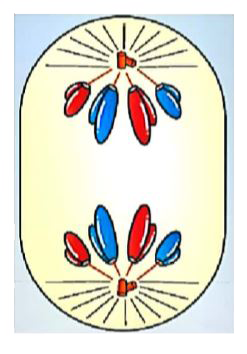Selelct the incorrect mathc regarding mitotic cell division.
(i)Prophase−Chromosomes begin to uncoil(ii)Metaphase−Chromatids move aprt(iii)Telophase−The nuclear membrane reappears(iv)Late−Each chromosome consists of two(v)Interphase−Chromosomes are not distinct
ii and iv only
i and iii only
ii,iv and v only
i and v only
The correct Answer is:A
Chromatids move apart in anaphase stage of cell divison. In alte anaphase, splitting of centromere occurs so chromatids of a chromosome separate apart.
Topper's Solved these Questions
Similar Questions
Which of the following statements is associated with
A prophase
B metaphase,
C anaphase,
D telophase,
E interphase of mitosis?
(a)The nuclear membrane reappears
(b)Chromosomes are thickest and shortest
(c)Chromosomes begin to uncoil
(d)Chromatids move apart
(e)Nucleus is active but chromosomes are not distinct
(f)Followed by cytokinesis
(g)Each chromosome consists of two chromatids.
View SolutionMathc column I with column II and select the correct option from the given codes.
Column IColumn IIChromosomes move to equator(i)PachyteneCentromere splits and (ii)ZygotenePairing between homologous chromosomes(iii)AnaphaseCrossing over between homologous chromosomes(iv)Metaphase
View Solution
Knowledge Check
Match the stages of meiosis in Column I to their characteristic features in Column II and select the correct option using the codes given below
Column-IColumn-IIPachytene(i)Pairing of homologous chromosomesMetaphase I(ii)Terminalization of chiasmataDiakinesis(iii)Crossing-over takes placeZygotene(iv)Chromosomes align at equatorial plateAABCDiviiiiiiBABCDiiiiviiiCABCDiiviiiiiDABCDiiiviiiiThe chromosomes which do not take part in cell division are
I. L-chromosome
II. Acentric
III. Polycentric
IV. DicentricAOnly IIBI and IICIII and IVDOnly ISelect the correct option:
III(a)Synapsis aligns homologous chromosomes(i)AnaphaseII(b)Synthesis of RNA and protein(ii)G2phase(c)Action of enzyme recombinase(iii)Diplotene(d)Centromeres do not separte but chromatids move towards opposite poles(iv)Anaphase PachyteneA(a)(b)(c )(d)(ii)(iii)(iv)(v)B(a)(b)(c )(d)(ii)(i)(iii)(iv)C(a)(b)(c )(d)(ii)(iii)(v)(iv)D(a)(b)(c )(d)(iii)(ii)(v)(i)
Match column I with column II and select the correct option from the given codes
Column IColumn IIA.Sickle cell anaemia(i)7th chromosomeB.Pheylketonuria(ii)4th chromosomeC.Cystic fibrosis(iii)11th chromosomeD.Huntington's disease(iv)X-chromosomeE.Colourblindness(v)12th chromosome
View SolutionMatch the column I with column II and select the correct option from the given codes.
Column IColumn IIDisintegration of nuclear membrane(i)AnaphaseAppearance of nucleolus(ii)ProphaseDivision of centromere(iii)TelophaseReplication of DNA(iv)S-phase
View SolutionThe figure given below represents the stage of cell division. Read the following statements.

(i) Nucleolus, Golgi complex and ER reform.
(ii) Chromatids move to the opposite pole.
(iii) The activity of the recombinase enzyme.
(iv) Homologous chromosomes separate while sister chromatids remains associated at their centromere.
(v ) Initiated of the assembly of the mitotic spindle.
How many of the above statements is not true with respect to the above figure-
View SolutionFind the correct match
(a)Anaphase I(i)Splitting of the centromere(b)Anaphase II(ii)Recombinase(c)Pachytene(iii)Sister chromatids associated at their centromeres(d)Diakinesis(iv)Chromosomes aligned on the equatorial plate(v)Nucleolus disappears
View SolutionMatch the following events that occur in their respective phases of cell cycle and select the correct option:
1.G1 phase(i)Cell grows and organelle duplication2.S phase(ii)DNA replication and chromosome duplication3.G2 phase(iii)Cytoplasmic growth4.Metaphase in M-phase(iv)Alignment of chromosomes
View Solution
